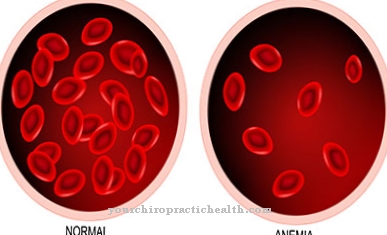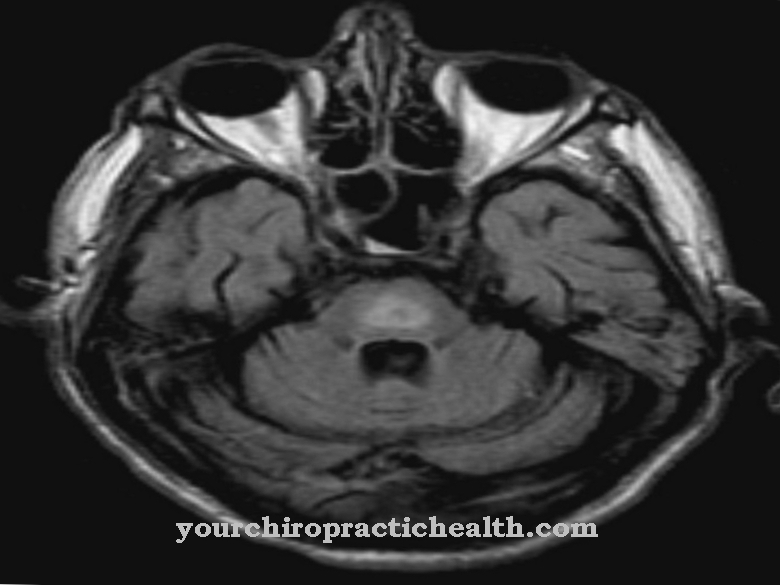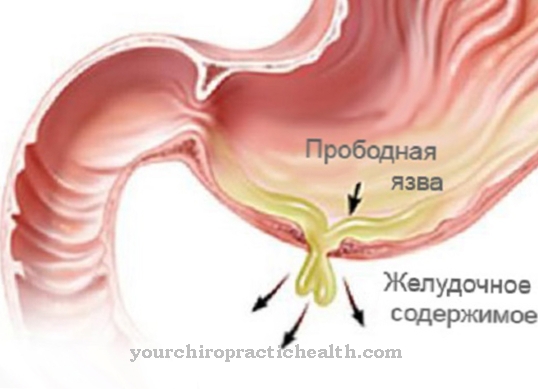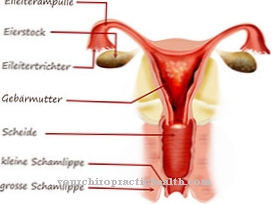Under Bladder diverticula are protrusions on the bladder wall that have the shape of a sack. It is important to distinguish between true diverticula and pseudodiverticula.
What are bladder diverticula?

© gritsalak - stock.adobe.com
For bladder diverticula or Bladder diverticulum are sac-like protuberances that appear on the wall of the urinary bladder. Depending on whether only the mucous membrane of the urinary bladder or all the wall layers prolapse, we speak of real diverticula or pseudodiverticula. Doctors differentiate between bladder diverticula based on whether the diverticulum is congenital or acquired in the course of life.
The congenital bladder diverticula affect the entire wall of the urinary bladder. As a result, the structure of the diverticulum wall resembles that of the bladder wall. The congenital bladder diverticula can be found on the muscles of the bladder wall, more precisely on the Ureteric hiatus. Acquired bladder diverticula also carry the name Pseudodiverticulum. They occur at muscular weak points in the bladder lining.
causes
In some cases, urinary bladder diverticula have existed since birth. It is not uncommon for them to be associated with vesicoureteral reflux. Specific complaints usually show up from the age of 10. A common cause of diverticulum formation is congenital weaknesses in the wall of the urinary bladder. This applies primarily to the ureter orifice. In addition, malformations of the urachus in the bladder roof area can be responsible for congenital diverticula.
However, some urinary bladder diverticula are diverticula and have herniated all of their wall layers. Acquired bladder diverticula are mostly formed by neurogenic diseases of the urinary bladder. In most cases, this leads to a constant increase in pressure in the bladder of the person concerned. This pressure causes the urinary bladder mucosa to protrude through open areas on the muscle wall.
The most common triggers include neurogenic dysfunction such as detrusor-sphincter dyssynergy, a benign enlargement of the prostate that affects older men over 50, and urethral valves that occur in children. An inadequate bladder suture can also be responsible for the formation of a diverticulum.
Congenital bladder diverticula are both true diverticula and pseudodiverticula. In some cases, the ureter (ureter) opens into the diverticulum. The term pseudodiverticulum is used when there is not a herniation in all layers of the urinary bladder wall. The wall of the diverticulum is made up of connective tissue, mucous membrane and some smooth muscle parts.
As the diverticulum is formed, a pseudocapsule also forms around its wall. This helps with the resection of the diverticulum. A diverticular neck that is narrow and sphincter-like is also considered typical. It has an intensifying effect on the urinary stasis within the diverticulum.
Symptoms, ailments & signs
Since bladder diverticula do not produce any specific symptoms, they often go unnoticed by those affected. Occasionally, however, urine may collect in a pocket-shaped diverticulum. This amount is not affected by urine excretion during urination. Because of the remaining urine, patients often feel that they have not completely emptied their bladder.
In addition, bladder diverticula can be responsible for chronic urinary tract infections. In some cases, urinary stones even form within the diverticulum. Only very rarely does a tumor develop on a diverticulum floor.
Diagnosis & course
To diagnose bladder diverticula, the attending physician first reviews the patient's medical history (anamnesis). This is followed by a physical examination. Performing imaging tests such as an X-ray contrast agent examination is considered helpful for the diagnosis.
A sonography (ultrasound examination) is also useful. In this way, the bladder diverticula can be easily recognized in a filled state. The diagnosis can be confirmed by a micturition cystourethrogram (MCU). It is important to assess the extent to which the diverticulum has been filled after the micturition has ended. Both the diverticulum and the urinary bladder mucosa can be assessed in the course of a cystoscopy (uroscopy).
If certain sections appear suspicious, a biopsy (tissue removal) can be performed. If the bladder diverticula are treated, this will in most cases result in a positive outcome. So they can usually be removed without any major problems. In the case of congenital diverticula, therapy is often not necessary at all if there is no vesicorenal reflux.
Complications
In most cases, the bladder diverticula will not cause specific discomfort or pain. This disease is therefore rarely recognized or specifically diagnosed, so that in most cases early treatment of the bladder diverticula is not possible. Likewise, the patient's urination is not affected by the disease, and the amount does not change either.
However, the person concerned always feels that the bladder has not been completely emptied. In the long run, this feeling can lead to psychological complaints or depression and has a negative effect on the patient's everyday life. It is not uncommon for those affected to drink less specifically so that urination does not occur frequently. The bladder diverticula increase the risk of developing kidney stones, so that these can also occur as the disease progresses.
Treatment of the bladder diverticulum usually does not lead to complications. In most cases, surgical interventions are used to resolve the symptoms. In severe cases, the patient is dependent on a catheter, which limits everyday life to a relatively large extent. As a rule, life expectancy remains unaffected by the disease.
When should you go to the doctor?
If after urinating you get the feeling that your bladder has not been completely emptied, you may have a bladder diverticulum. A doctor should be consulted if the symptoms have not subsided after a week at the latest. If there are signs of a urinary tract infection, medical advice is required. Urinary stones can also indicate a diverticulum and should be examined by a urologist or internist and removed if necessary.
If a bladder diverticulum is not removed, a tumor can develop in the worst case. The warning signs for such a severe course include pain and restraint when urinating, frequent urination and increasing pressure pain in the urinary bladder.
If you notice these symptoms, you should speak to your doctor immediately. A visit to the hospital is indicated if the symptoms are severe. In case of doubt, the emergency medical service can be contacted first. In general, a bladder diverticulum must be clarified and removed in order to enable a quick recovery and to avoid further complications.
Doctors & therapists in your area
Treatment & Therapy
Various measures are used to treat urinary bladder diverticula. Permanent catheterization is performed in patients for whom surgical removal appears to be too risky. In some cases, intermittent self-catheterization is also possible. Treatment with an endoscope can be used to resect a too narrow diverticulum neck.
This method occurs with marginally significant diverticula. In addition, coagulation takes place, which initiates a scarred shrinkage of the bladder diverticulum. In most cases, surgery is done to remove the bladder diverticula, especially if the diverticulum is large. Different methods are used for this.
Smaller diverticula are treated with an open surgical transvesical diverticulum resection. This is often done in conjunction with a transvesical prostate adenomectomy. The extravesical diverticulum resection is another possible surgical therapy method. It is particularly suitable when larger bladder diverticula occur.
This method is performed either in a minimally invasive manner using a laparoscopy with a special endoscope or in an open manner. This depends on whether implantation of a ureter or prostate deobstruction is required at the same time.
Outlook & forecast
The prognosis for bladder diverticula is favorable. If they are discovered and treated at an early stage, there will be no symptoms within a short time. In a large number of cases, surgical interventions are performed to completely remove the foreign body. As with any surgery, it is associated with the usual risks and side effects. If there are no complications and the wound is healing well, the patient can usually be expected to recover within a few weeks.
Laser treatment is often sufficient for smaller bladder diverticula. The foreign bodies are shattered by the action of the laser beam and then independently transported away from the body and excreted by the organism.
If the patient's living conditions and health care are not restructured, the bladder diverticula are likely to recur. If the foreign bodies appear again, the prognosis is also favorable. The sooner the diagnosis is made, the better and easier the therapy is.
Without treatment, there is a continuous increase in symptoms. In severe cases, a backlog of urine can be expected. Bacteria and germs develop as a result, so that secondary diseases develop. In addition, organ damage is possible, which always represents a potential threat to life and contributes to a shortening of the expected life of the patient.
prevention
Since bladder diverticula are often congenital, there are no suitable preventive measures. In order to counteract acquired bladder diverticula, the causative diseases would have to be avoided, but this is difficult.
Aftercare
The diagnosis measures usually depend on the severity of the diverticulum, so that no general prediction can be made. In general, an early diagnosis and detection of the symptoms has a very positive effect on the further course of the disease, so that the person affected should contact a doctor as soon as the first symptoms and complaints appear.
The earlier the disease is recognized by a doctor, the better the further course is usually also. In most cases, the person affected with this disease is dependent on an operation that can relieve the symptoms over the long term. After such a procedure, bed rest should be maintained, with the person resting and avoiding stressful or physical activity.
Regular checks and examinations by a doctor are also very important after a successful procedure and can prevent further complications or complaints. The life expectancy of the person affected is usually not reduced by the disease. Antibiotics should be taken after the surgery to prevent infection or inflammation. It is important to ensure that the dosage is correct and that it is taken regularly.
You can do that yourself
If a urinary bladder diverticulum has been found, the person concerned should primarily rest until the diverticulum is surgically removed or treated with the help of an indwelling catheter.
In addition, after diagnosis, hospitalization precautions must be taken. The urinary bladder must not be subjected to any further stress in order to avoid an increase in symptoms and possible complications. Patients should therefore make sure that there is no flu-like infection or any other illness that could additionally damage the urinary bladder or the urinary tract.
From then on, the usual measures must be initiated. Relatives and friends must be informed about the stay in the clinic, as well as the employer and the health insurance company, which usually pays the costs for the procedure.
After an operation, the affected person should initially take it easy. The surgical wound takes at least a week to heal. Then you can slowly return to everyday life. When you can go back to work depends on the type of treatment and the course after the procedure. It is best for those affected to speak to the responsible doctor and clarify any activities in advance.






.jpg)

















.jpg)



